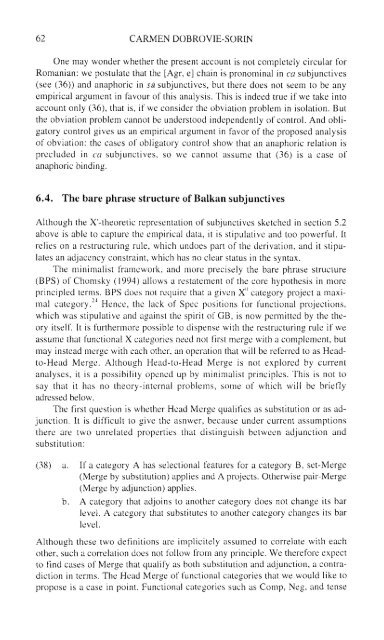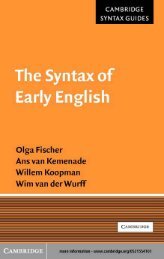Comparative Syntax of the Balkan Languages (Oxford ... - Cryptm.org
Comparative Syntax of the Balkan Languages (Oxford ... - Cryptm.org
Comparative Syntax of the Balkan Languages (Oxford ... - Cryptm.org
- No tags were found...
You also want an ePaper? Increase the reach of your titles
YUMPU automatically turns print PDFs into web optimized ePapers that Google loves.
62 CARMEN DOBROVIE-SORINOne may wonder whe<strong>the</strong>r <strong>the</strong> present account is not completely circular forRomanian: we postulate that <strong>the</strong> [Agr, e] chain is pronominal in ca subjunctives(see (36)) and anaphoric in sa subjunctives, but <strong>the</strong>re does not seem to be anyempirical argument in favour <strong>of</strong> this analysis. This is indeed true if we take intoaccount only (36), that is, if we consider <strong>the</strong> obviation problem in isolation. But<strong>the</strong> obviation problem cannot be understood independently <strong>of</strong> control. And obligatorycontrol gives us an empirical argument in favor <strong>of</strong> <strong>the</strong> proposed analysis<strong>of</strong> obviation: <strong>the</strong> cases <strong>of</strong> obligatory control show that an anaphoric relation isprecluded in ca subjunctives, so we cannot assume that (36) is a case <strong>of</strong>anaphoric binding.6.4. The bare phrase structure <strong>of</strong> <strong>Balkan</strong> subjunctivesAlthough <strong>the</strong> X'-<strong>the</strong>oretic representation <strong>of</strong> subjunctives sketched in section 5.2above is able to capture <strong>the</strong> empirical data, it is stipulative and too powerful. Itrelies on a restructuring rule, which undoes part <strong>of</strong> <strong>the</strong> derivation, and it stipulatesan adjacency constraint, which has no clear status in <strong>the</strong> syntax.The minimalist framework, and more precisely <strong>the</strong> bare phrase structure(BPS) <strong>of</strong> Chomsky (1994) allows a restatement <strong>of</strong> <strong>the</strong> core hypo<strong>the</strong>sis in moreprincipled terms. BPS does not require that a given X 1 category project a maximalcategory. 24 Hence, <strong>the</strong> lack <strong>of</strong> Spec positions for functional projections,which was stipulative and against <strong>the</strong> spirit <strong>of</strong> GB, is now permitted by <strong>the</strong> <strong>the</strong>oryitself. It is fur<strong>the</strong>rmore possible to dispense with <strong>the</strong> restructuring rule if weassume that functional X categories need not first merge with a complement, butmay instead merge with each o<strong>the</strong>r, an operation that will be referred to as Headto-HeadMerge. Although Head-to-Head Merge is not explored by currentanalyses, it is a possibility opened up by minimalist principles. This is not tosay that it has no <strong>the</strong>ory-internal problems, some <strong>of</strong> which will be brieflyadressed below.The first question is whe<strong>the</strong>r Head Merge qualifies as substitution or as adjunction.It is difficult to give <strong>the</strong> asnwer, because under current assumptions<strong>the</strong>re are two unrelated properties that distinguish between adjunction andsubstitution:(38) a. If a category A has selectional features for a category B, set-Merge(Merge by substitution) applies and A projects. O<strong>the</strong>rwise pair-Merge(Merge by adjunction) applies.b. A category that adjoins to ano<strong>the</strong>r category does not change its barlevel. A category that substitutes to ano<strong>the</strong>r category changes its barlevel.Although <strong>the</strong>se two definitions are implicitely assumed to correlate with eacho<strong>the</strong>r, such a correlation does not follow from any principle. We <strong>the</strong>refore expectto find cases <strong>of</strong> Merge that qualify as both substitution and adjunction, a contradictionin terms. The Head Merge <strong>of</strong> functional categories that we would like topropose is a case in point. Functional categories such as Comp, Neg, and tense
















